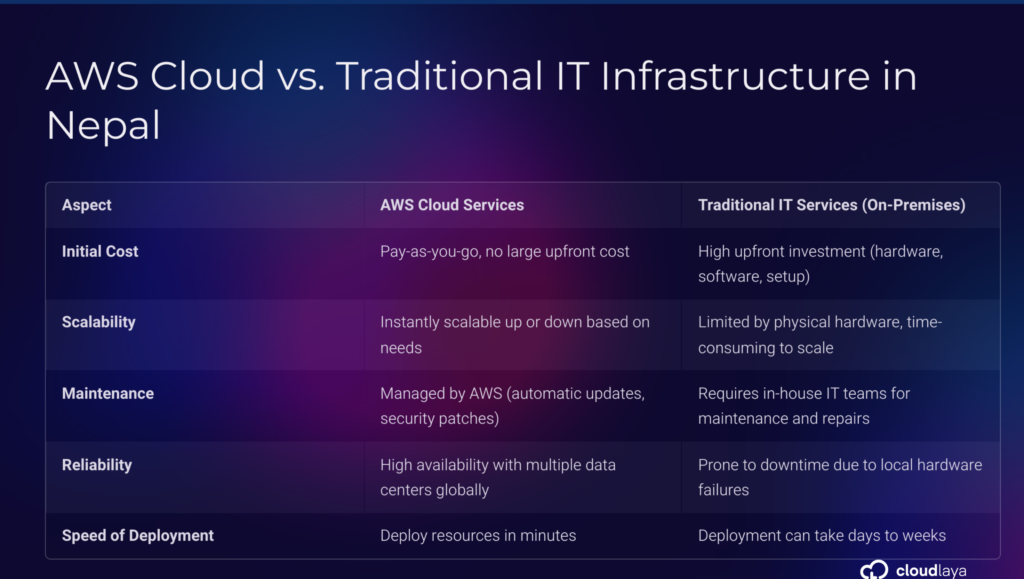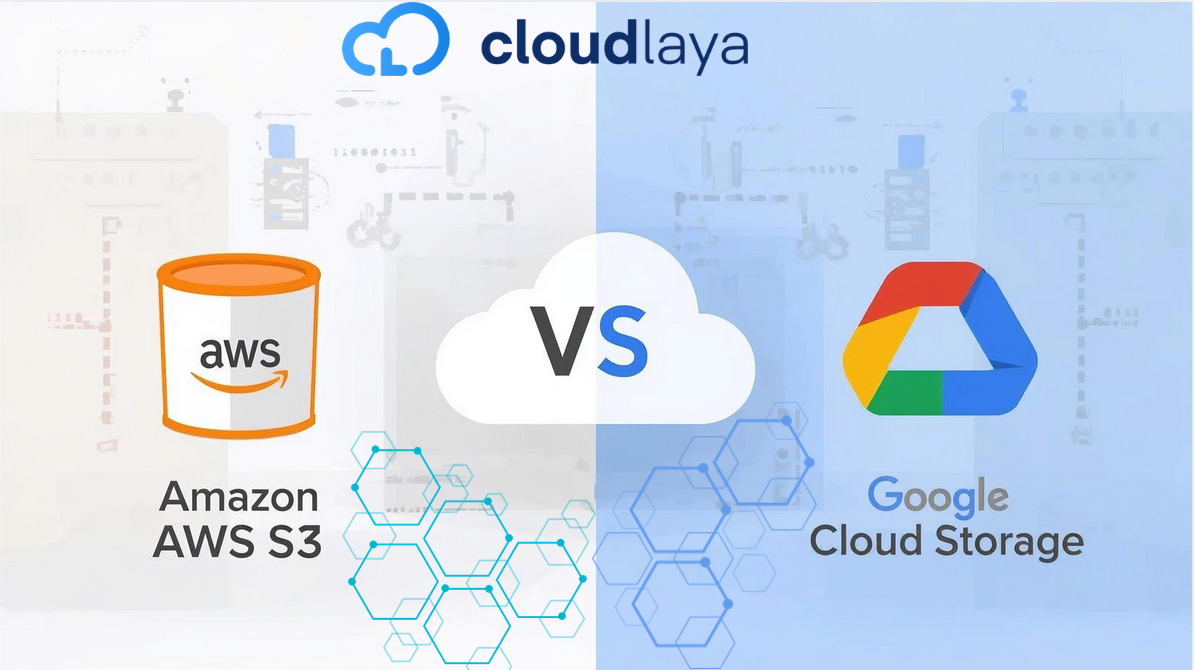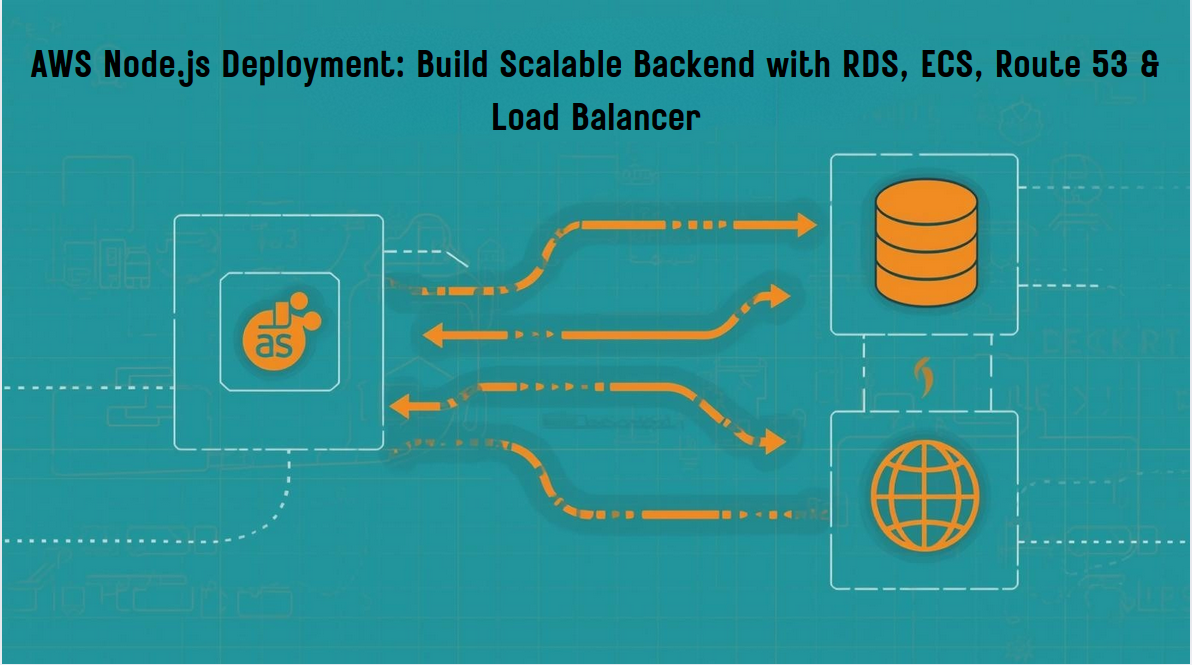
AWS Cloud in Nepal: Transforming the Digital Landscape
Nepal stands at a turning point, with technology opening up new opportunities across every industry. Right now, AWS Cloud in Nepal is making a real difference for businesses, startups, and institutions looking to modernize and grow. This isn’t just a trend—it’s the backbone of a new digital era here.
So, what exactly is AWS Cloud in Nepal doing? In simple terms, it gives companies access to powerful computing resources (think storage, servers, databases, and more) without needing to buy expensive hardware or manage complicated tech setups. It’s flexible, secure, and scales as your needs change—which means even small teams can compete on a bigger stage.
The impact is already visible. With AWS Cloud in Nepal, organizations are launching new services faster, cutting costs, and reaching more people—whether it’s a local startup, an established business, or even government agencies making services more accessible.
If you’re wondering what to do next, start by looking at what your business needs most: is it better data storage, more reliable apps, or faster service for your customers? Explore AWS Cloud solutions that fit those needs. There are plenty of resources and local partners that can help you get started, no matter your size or experience.
In short: AWS Cloud in Nepal is changing the game for anyone ready to embrace digital transformation. Now’s the time to learn, adapt, and take advantage of what the cloud can offer.
Alright, let’s break this down—no jargon overload, no fluffy distractions. Just straight answers, crystal clear.
Understanding AWS Cloud in Nepal
First up, AWS Cloud is like renting super high-powered computers and storage space online, instead of buying a bunch of expensive equipment for your office. You pay only for what you use, and you don’t have to worry about repairs or upgrades. This is a total game-changer for businesses in Nepal, because it means you can launch new projects or scale up quickly—no massive upfront investment needed.
Here’s how AWS Cloud works in Nepal (or anywhere, really):
Alright, let’s clean up the casualness and get a bit more technical, but still keep it human.
AWS packs well over 200 services, but you only need to know the essentials to start—especially for businesses in Nepal.
Here’s the breakdown:
1. Compute:
- Amazon EC2: provides scalable virtual machines (instances) in the cloud. You can deploy anything from a basic website to a complex enterprise application. It’s flexible—spin up or terminate servers as your needs change, and you only pay for what you use. [Learn More About Amazon EC2]
- AWS Lambda: is the serverless option. You upload your code, define triggers, and AWS handles the rest—no server management, no provisioning. Billing is based on actual compute time, making it a cost-effective choice for event-driven workloads.[ Learn More AWS lambda]
2. Storage:
- Amazon S3: It is the go-to for object storage. It’s highly scalable and durable, making it ideal for backups, static website assets, analytics datasets, and more. Data is accessible when you need it, with robust security options.[Learn More About amazon S3]
- Amazon EBS: offers block storage that attaches to EC2 instances. It’s similar to a hard drive for your cloud server: persistent, high-performance, and easily backed up or restored. [Learn More About Amazon EBS]
3. Databases:
- Amazon RDS: simplifies the deployment and maintenance of relational databases like MySQL, PostgreSQL, and SQL Server. You get automated backups, patching, and scaling—without the overhead of managing the underlying infrastructure.
- DynamoDB: is AWS’s fully managed NoSQL solution. It’s built for low-latency, high-throughput use cases, like real-time applications or services with unpredictable traffic.
4. Networking & Content Delivery:
- Amazon VPC: It lets you carve out a private, isolated segment of the AWS cloud, where you control networking, IP addressing, security groups, and routing—basically, your own virtual data center.
- Amazon CloudFront: It is AWS’s Content Delivery Network (CDN). It caches your content at edge locations worldwide, reducing latency and improving load times for users in Nepal and globally.
To sum up: AWS is massive, but most businesses start with these core services. They cover the main technical needs—from hosting and storage, to databases and network architecture. Start with what you need and expand as your business grows.

The Impact of AWS Cloud on Nepal’s Economy
The adoption of AWS is not just a technological upgrade; it’s a powerful economic driver. The ripple effects of AWS Cloud in Nepal are being felt across key sectors, fostering a more dynamic and resilient economy.
1. Role in Startup Growth
For years, launching a startup in Nepal felt like an uphill battle—mostly thanks to the ridiculous costs of IT setup. Think about it: buying servers, sorting out backup power (hello, load shedding!), and hiring tech talent? That was a lot to ask, especially for new founders juggling a dozen other things.
Enter AWS Cloud in Nepal, and the whole scene changed overnight. Now, even a tiny team in Kathmandu can tap into world-class, enterprise-worthy infrastructure without breaking the bank. We’re talking Silicon Valley-level tech, but on a shoestring budget.
Here’s what’s different now:
- Lower Barrier to Entry: With AWS Cloud in Nepal, startups can skip the giant upfront investment. More cash for building products and hustling on marketing, less wasted on hardware.
- Rapid Prototyping: Testing new ideas? Go from concept to launch in a day or two. If your idea bombs, you’re not left crying over sunk costs.
- Effortless Scalability: When your app suddenly blows up (hey, it happens!), AWS Cloud in Nepal handles the traffic so your site doesn’t implode. Ride-sharing, SaaS, fintech—everyone’s scaling without fear.
Honestly, the way the startup vibe has exploded here is proof enough: AWS Cloud in Nepal isn’t just a tool, it’s the backbone of this whole new wave of innovation.
2. Influence on E-commerce Development
- Managing Crazy Traffic: Picture this—festival season or Black Friday rolls around, and your site gets flooded with shoppers. Without AWS Cloud in Nepal, handling those wild spikes would be a nightmare. AWS lets businesses boost server power exactly when they need it, then dial it back down to keep costs under control.
- Keeping Security Tight: Security’s a huge deal, no way around it. With tools like AWS Shield and AWS WAF, these platforms can guard sensitive customer data and keep bad actors at bay. That builds trust, which is priceless in e-commerce.
- Personalization Game Strong: Thanks to AWS Cloud in Nepal, companies can tap into analytics and machine learning to really get to know their customers. Personalized recommendations mean happier shoppers and, yep, more sales.
Bottom line? If you’re in Nepal’s e-commerce game, AWS Cloud in Nepal isn’t just a nice-to-have—it’s the secret weapon behind the scenes.
3. Contributions To Educational Institutions
- AWS Educate & AWS Academy: AWS cloud in Nepal is opening doors for students and educators to actually get hands-on with cloud stuff, not just read about it in a textbook. Free credits, legit training materials, and guided learning paths—honestly, it’s the kind of head start you wish you had before job hunting.
- Research Computing: Let’s be real, most universities in Nepal aren’t dropping millions on supercomputers. With AWS cloud in Nepal, researchers can run massive calculations—whether it’s genomics, climate data, or whatever big-data project they dream up—without sweating the hardware bills. You just rent what you need, when you need it. Simple.
- Online Learning Platforms: Ever since COVID turned everything upside down, schools needed reliable online spaces. AWS cloud in Nepal makes it possible to host sturdy e-learning platforms, so you don’t get that “server crashed, try again later” message every other day. It’s a smoother ride for students and teachers, pandemic or not.
Why are businesses across Nepal making the switch?
The benefits are clear, compelling, and aligned with the needs of a growing economy. Adopting the AWS Cloud in Nepal offers a distinct competitive advantage.
Advantages of AWS Cloud Adoption In Nepal.
1. Efficiency and Scalability
Here’s the deal: AWS Cloud in Nepal is a total game-changer for businesses looking to ditch the old “buy a bunch of servers and hope for the best” routine. In the past, companies had to shell out for way more hardware than they actually used—just in case traffic spiked. Mostly, those servers sat around doing nothing but draining money.
Scale on Demand: With AWS Cloud in Nepal, you can scale on-demand. Need more resources? Spin them up instantly. Traffic drops? Scale back and save cash.
Auto Scaling feature: Means you don’t have to sit there micromanaging everything—AWS handles it for you, keeping performance steady without blowing your budget.
Global Reach: If your business is going global, it’s not some huge headache anymore. You can roll out your apps in multiple locations worldwide, super-fast, to reach customers wherever they are. That’s next-level flexibility and efficiency without the old-school hassle.
2. Cost Effectiveness
- AWS Cloud in Nepal is kind of a game-changer for IT budgets.
- Instead of throwing a ton of money into hardware upfront (those big scary CAPEX purchases), you switch to paying only for what you actually use—OPEX style.
- No sneaky long-term contracts, no weird licensing headaches. Just straightforward, pay-as-you-go.
- Forget about buying servers, finding space for them, or dealing with the nightmare of keeping them cool (or fixing them when they break). With AWS Cloud in Nepal, all the heavy lifting—hardware, maintenance, power—is handled by Amazon. You just use what you need and get a bill at the end of the month. Easy.
And because AWS is, well, AWS, they buy in bulk and run at a scale that local providers can only dream about. Those cost savings? They trickle down to you. So, for most businesses starting their journey with AWS Cloud in Nepal, the first thing they notice is a solid drop in IT spending. That’s money you can put back into growing your business, not just keeping the lights on

3. Support For Innovation
Let’s be real: aws cloud in nepal is a total game-changer. It’s not just about servers humming away somewhere—it’s a launchpad for serious innovation. When AWS handles the heavy infrastructure lifting, your team finally gets to focus on building cool stuff, not babysitting hardware.
Here’s how aws cloud in nepal is shaking things up:
- Artificial Intelligence (AI) & Machine Learning (ML): Tools like Amazon SageMaker make it a breeze to build, train, and deploy models. Suddenly, machine learning isn’t just for the tech giants.
- Internet of Things (IoT): With AWS IoT Core, connecting and managing a ton of devices actually becomes manageable. No more tech chaos.
- Data Analytics: Services like Amazon Redshift and Athena turn your mountain of data into real insights. Now you can make decisions based on facts, not just gut feelings.
Bottom line? With aws cloud in nepal, businesses can experiment, innovate, and grow—without getting bogged down by the boring backend stuff. That’s real progress.
Current Adoption Levels of AWS Cloud in Nepal
The adoption of AWS Cloud in Nepal is on a steep upward trajectory, moving from early adopters to mainstream acceptance
1. Factors Driving Digital Transformation
- Internet Boom: Let’s be real—affordable 4G has changed the game. With more people online than ever, AWS cloud in Nepal isn’t just possible, it’s kind of inevitable.
- Smartphone Takeover: Nepal’s got a young crowd, and they’re glued to their screens. From mobile banking to ordering late-night snacks, everyone’s expecting smooth digital experiences. Guess what’s running behind the scenes? Yep, AWS cloud in Nepal.
- Government Gets Digital: The push from officials to move services online? It’s creating a playground for cloud tech. Renew a license, file some paperwork—cloud’s making it easier. AWS cloud in Nepal is right in the mix.
- Pandemic Push: COVID hit, and suddenly every business needed to go online overnight. Remote work, online sales, you name it—AWS cloud in Nepal helped companies adapt fast and keep going.
So, between faster internet, a phone-happy generation, digitizing government, and the pandemic’s digital kickstart, AWS cloud in Nepal is riding a major wave. And honestly? It’s just getting started.
2. Supportive Government Policies
Nepal’s Digital Nepal Framework is basically the blueprint for dragging the country’s systems into the digital age—think online education, smarter healthcare, and city upgrades. Here’s the thing: none of this really works without the power of cloud computing.
That’s where AWS Cloud in Nepal steps in. As the government upgrades its own tech, AWS Cloud in Nepal isn’t just a buzzword; it’s the backbone making everything tick.
Once the public sector gets it right, you can bet the private sector will want in, setting off a wave of digital transformation across the board.
What Are the Challenges in Adopting AWS Cloud?
Despite the immense potential, the path to widespread cloud adoption in Nepal is not without its hurdles
1. Need for Skilled Workforce
Honestly, the skills gap is the elephant in the room. AWS Cloud in Nepal is moving fast, but the talent pool? Not really keeping pace. There’s a real crunch for AWS-certified folks—Solutions Architects, DevOps Engineers, Cloud Practitioners, you name it.
Companies are practically fighting over the handful of people who actually know what they’re doing when it comes to designing and running cloud setups. If AWS Cloud in Nepal wants to level up, investing in up-skilling and training is a must.
2. Internet Infrastructure Limitations
Now, let’s talk about internet infrastructure. Progress? Sure. But step outside Kathmandu or Pokhara, and reliable, high-speed internet is still hit-or-miss. For businesses needing solid, always-on connections to the cloud, issues like high latency and spotty service are a serious pain.
AWS services like CloudFront (with that Edge Location in India) do help, but they can’t fix the last-mile connectivity problem. Until that’s sorted out, it’s going to keep holding back cloud performance in Nepal.
Solutions for Adoption Challenges
Fortunately, the Nepali tech community and AWS partners are actively working to overcome these challenges
1. Community-Driven Learning Initiatives
A strong, engaged community is honestly one of the smartest ways to tackle the skills gap. If you look at the growth of AWS Cloud in Nepal, you’ll see this in action. Here’s what’s happening:
- AWS User Group Nepal: This isn’t just another online group. It’s full of AWS fans, pros, and beginners who actually meet up, talk shop, swap advice, and help each other level up with cloud tech.
- Workshops and Bootcamps: Across Nepal, you’ll find bootcamps and workshops run by training centers and some pretty inspiring community leaders. These sessions go beyond theory—they’re all about hands-on experience, often focused on AWS certifications and real-world cloud skills.
Honestly, these community-driven projects are the backbone for building the local talent needed to keep the momentum going with AWS Cloud in Nepal. When people learn together, everyone wins
2. AWS-Managed Services
When it comes to handling the skills shortage, businesses really don’t have to panic.
AWS managed services are a total game changer here. Take Amazon RDS for databases, AWS Fargate for containers, or Elastic Beanstalk for web apps—they all take care of the complicated backend stuff automatically.
This means even smaller IT teams can actually use the aws cloud in nepal without needing to hire a bunch of experts. Basically, AWS is making it way easier and more practical for companies to get in on the action, no matter their team’s size or experience level
3. Role of Local Partners in AWS Cloud in Nepal
Let’s be real—tackling the AWS cloud in Nepal solo? That’s a tall order for most businesses. The landscape’s tricky, the tech can get overwhelming, and honestly, there’s just too much on the line to wing it. That’s where local AWS partners step up, turning chaos into something way more manageable.
i.Spotlight on Cloudlaya
As a legit AWS advanced tier partner in Nepal, Cloudlaya acts as the go-between for all that fancy AWS global infrastructure and what businesses here actually need. Their impact? Pretty major:
- Local Know-How and Support: Cloudlaya gets the ups and downs of doing business in Nepal. They’re tuned into local challenges and opportunities, so their advice actually makes sense here.
- Cloud Consulting & Migration: Trying to move your business to the AWS cloud in Nepal? They’ll walk you through the whole thing—figuring out your needs, designing a setup that fits, and making sure the switch is smooth, no meltdowns required.
- Billing and Management Made Simple: Forget the headache of juggling foreign invoices. Cloudlaya handles billing in rupees, plus you get one local team for all your support and management questions.
- Partnering up with a local expert like Cloudlaya isn’t just a “nice option”—it seriously makes the AWS cloud in Nepal easier and less risky. So, why go it alone when you could have someone in your corner who speaks your language (literally and technically)?

ii. Performance & Cost Optimization: Why It’s a Big Deal
Let’s be real—when you team up with local partners for AWS Cloud in Nepal, you’re not just paying for someone to spin up your servers and call it a day. These folks are in it for the long haul, making sure things run smooth and your budget doesn’t explode.
- Cost Optimization: Local experts know their way around AWS tools, like Cost Explorer and Savings Plans. They’ll spot waste, trim the fat, and help you invest only where it matters.
- Performance Tuning: Your architecture isn’t a “set and forget” deal. These teams keep tabs on your setup, making sure your apps are fast, efficient, and always up when you need them.
- Security Audits: Regular Well-Architected Reviews help catch security issues early. Nobody wants a nasty surprise on the front page, right?
4. AWS Community Day Nepal: The Heartbeat of the Scene
If you want a real pulse check on AWS Cloud in Nepal, just show up at AWS Community Day Nepal. It’s where the community comes alive, sharing ideas, networking, and learning together. The energy is contagious—developers, startups, and IT pros all swapping tips and success stories.
i. Power of Local Expertise
Sure, global gurus have their place, but nothing beats hearing how a Nepali developer cracked a tough problem using AWS Cloud in Nepal. It’s concrete, relatable, and shows that serious innovation is happening right here. For the crowd, it’s proof that they can do it too—and that’s what really moves the needle.
ii. Knowledge-Sharing and Collaboration
AWS Community Day is honestly where the magic happens for the whole AWS cloud in Nepal scene. It’s got something for everybody:
- Beginners? They walk in curious and walk out with fresh ideas—maybe even a new career direction.
- Seasoned pros? They’re catching up, trading technical stories, and diving deep into the latest AWS tools.
- Businesses? Oh, they’re on the lookout for new solutions and the chance to meet top local talent.
If you’re serious about the AWS cloud in Nepal, this event is essential. It brings everyone together—sharing, learning, and building the connections that drive real progress.
Future Outlook
Alright, let’s get down to it—AWS Cloud in Nepal is really setting the stage for something big. The base is there, the momentum’s building, and it feels like we’re on the edge of a digital leap.
1.Potential Growth Opportunities
Look around, and you can see how AWS Cloud in Nepal could totally shake up different sectors:
- FinTech: Expect smarter, safer payment systems and maybe even those modern neo-banks finally making things easier.
- Agri-Tech: With IoT and data analytics, farming’s about to get a tech upgrade—better yields, smoother supply chains, the works.
- HealthTech: Secure digital health records, telemedicine that actually works, and AI-powered diagnostics—healthcare’s coming online, big time.
- Government Services: More efficient e-governance, less red tape, and a system that finally puts citizens first.
Strategies for Maximizing AWS Benefits
So how do Nepali businesses and the local tech scene really make the most of AWS Cloud in Nepal? Here’s what makes sense:
1.Invest in Education: Make cloud skills a priority—get people certified, push for better university programs, and keep the team sharp.
2. Foster the Community: Meetups, workshops, user groups—building a strong network is key.
3. Partner Strategically: Work with local AWS partners like Cloudlaya. They’ve got the know-how to help you get up to speed fast.
4. Start Small and Iterate: Don’t throw everything into the cloud overnight. Test things out, learn as you go, then scale up.
5. Embrace a Cloud-First Mindset: See the cloud as more than just tech—use it to drive business innovation and stay ahead of the curve.
Conclusion
The rise of AWS Cloud in Nepal isn’t just a tech trend—it’s a huge moment for the country’s business landscape. Startups can finally dream big, established companies get a chance to work smarter, and everyone gets the tools to build a digital Nepal.
Sure, there are challenges—skills gaps, infrastructure, you name it—but with a passionate community, solid local partners, and forward-thinking leaders, things are moving fast.
At this point, it’s not about “if” businesses should use AWS Cloud in Nepal, but “how soon” they can jump in to innovate, scale, and compete globally. The digital shift is here, and AWS Cloud in Nepal is driving it forward.



One thought on “AWS Cloud in Nepal: Transforming the Digital Landscape”